- Author Jason Gerald [email protected].
- Public 2023-12-16 10:50.
- Last modified 2025-01-23 12:04.
Whether you spill tea on the pages of your favorite book or accidentally drop a book in the tub while taking a bath while reading, you must take urgent action to save your books from water damage. While it is very sad to see your beloved book wet, there is a way out in a difficult situation like this. You can use a refrigerator, a hairdryer, a water absorption technique or aerating the book to restore it to its original state (or at least close to it).
Step
Method 1 of 4: Using Water Absorption Technique

Step 1. Remove excess water from the book
If the book is not completely wet, you can use a blotting technique. If the book gets spilled or falls into a puddle, pick it up by holding the back of the book, and shake it left and right to remove any excess water from the cover and pages of the book. After that do the water absorption technique carefully to minimize the possibility of ink smudging and wrinkled paper.
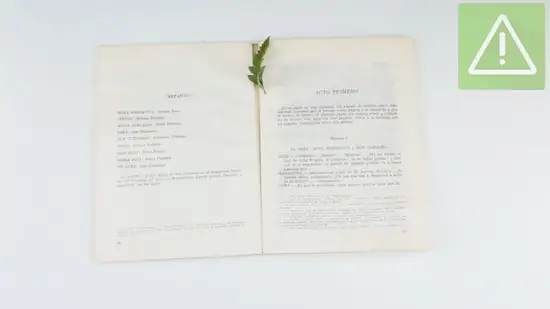
Step 2. Remove any dirt or debris
Carefully remove any dirt that may be left on the pages of the book. You may find wet leaves or candy wrappers if the book falls into a puddle. Make sure you remove all dirt to avoid further damage when you dry the book.
- To remove dirt from damp books, you can use your fingers or tweezers.
- If you need to remove dirt from a book that has fallen into a dirty puddle, prepare a tub of clean water, then carefully dip the book into the water so that the dirt comes off on its own. This method will remove dirt without damaging the pages of a book that is already wet.
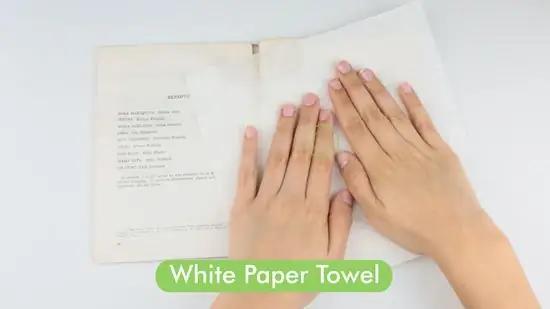
Step 3. Take a white towel and gently press the pages of the book to absorb the water
Do the same process for each page using a clean white cloth or towel. Do not rub the page with a cloth as this can tear the paper. Do this water absorption technique on one page carefully before moving on to the next.
If the pages are only slightly damp, you can place a napkin between each page. However, if the book is really wet, absorb water on the adhering pages without separating them
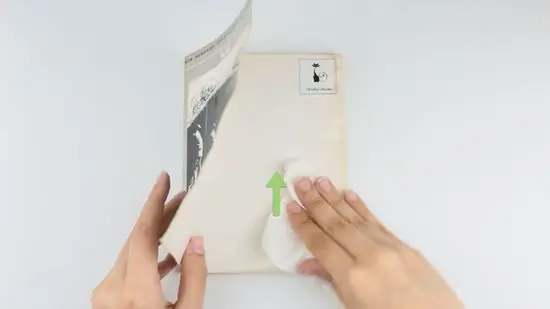
Step 4. Wipe and absorb excess water from the front and back covers
For paperback books, it is safest to use a water absorption technique to minimize the chance of tearing the paper. Hardback books can be wiped with a rag, but do so with care. Since covers are tougher and tougher than book pages, you don't need to rush through them.
Don't ignore the book cover. When you're done handling the pages of the book, make sure you dry the cover as well. Otherwise, water remaining on the cover can damage the binding and encourage mold growth
Method 2 of 4: Using the Freeze-Dry Technique
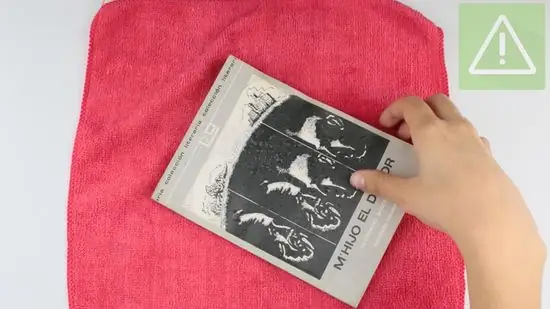
Step 1. Get rid of excess water
If the book is really wet, remove excess water by placing it on a paper towel or napkin. Let the water drain or drip. Change the wet napkin. If the book is only damp, you can gently shake it left and right.
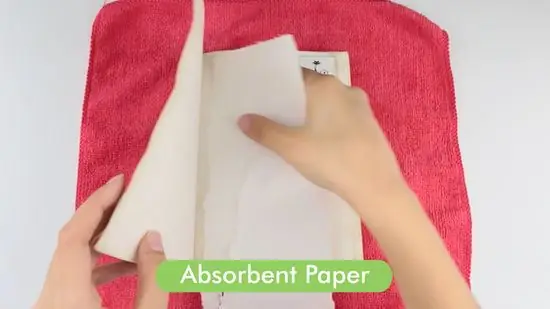
Step 2. Check the condition of the book
See if there is still a lot of water on the pages of the book. If so, then you haven't dried it properly. Hold the book face up and place a paper napkin on the inside of the front and back covers. This step helps speed up the drying process and keeps the binding intact.
Do not use absorbent paper (paper towels, newspapers, etc.) with writing or pictures as they may smudge and stick to the book
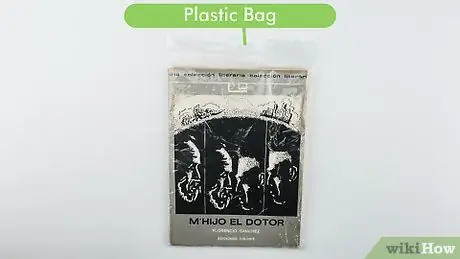
Step 3. Place the book in a plastic clip bag
Put the book in a plastic bag and secure the clip. Do not suck air from the bag. You must allow air to reach the pages of the book and allow space between the plastic and the book. You can also use a regular plastic bag.
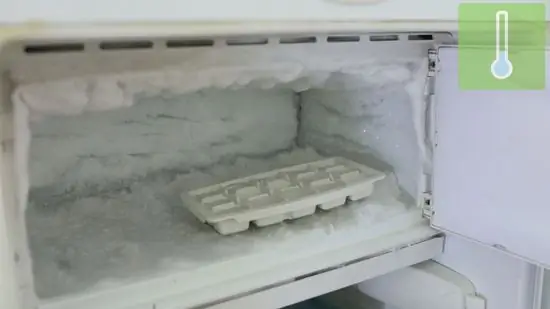
Step 4. Put the book in the freezer
Place the book face up. If possible, separate food from books and place them on separate shelves for easier air circulation.
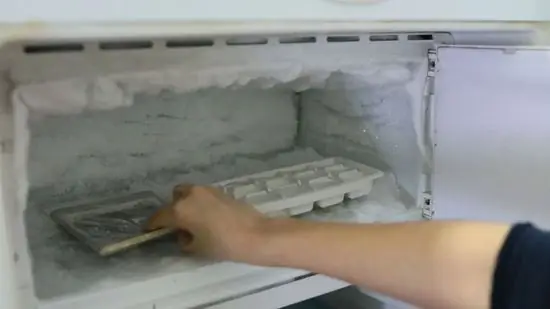
Step 5. Check the condition of the book in 1-2 weeks
It will take you some time to get the desired results, maybe 1-2 weeks, depending on the size of the book. Larger books will take longer, while smaller books will only take 4-5 days. If the pages are still wavy and wet, leave them in the freezer for a few more days.
If you follow the procedure correctly, the pages and ink of the book will remain intact
Method 3 of 4: Using a Fan
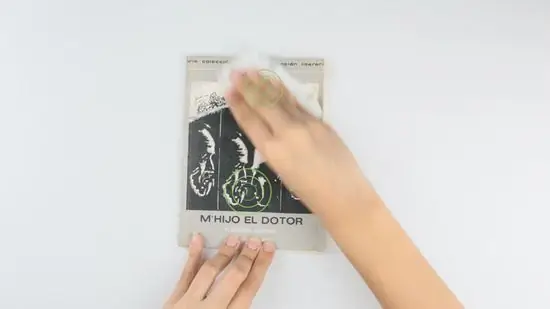
Step 1. Remove excess water from the book
This method is most effective for those that are only partially wet. A completely wet book will be difficult to fan dry. Remove excess water by shaking the book or using a water absorption technique.
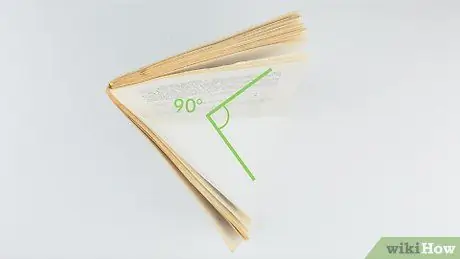
Step 2. Open the book cover so that it forms a 90 degree angle
Place the book face up and open the cover so that it forms a 90-degree angle while the pages of the book open like a fan. Try to open as many pages of the book as possible to allow for maximum airflow.
You'll get the best results if the book's pages are open, but don't try to separate pages that are stuck together. If you do so, the pages may tear or the ink will smudge
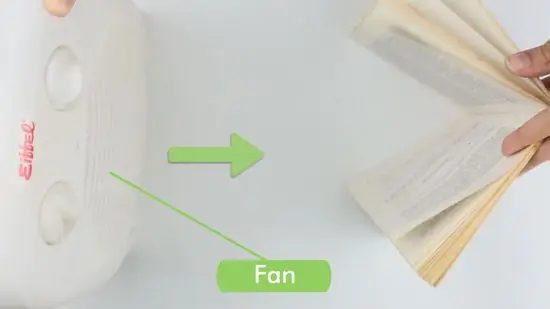
Step 3. Place the book near the fan
Place the book under a hanging fan, or in front of a desk fan. Turn on the fan on medium speed. Low speeds do not produce sufficient airflow, while high speeds can cause pages to fold and wrinkle. If the fan does not have a medium setting, use the lowest speed.
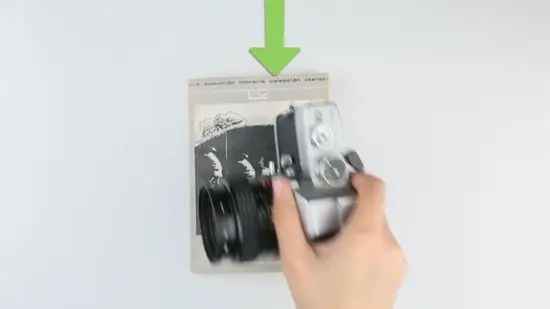
Step 4. Place a heavy object on top of a closed book to compress the wrinkled page
Use a bookweight, a boulder, or even a heavy book, to press the dry pages closed. Leave it for 24-48 hours. This step helps flatten out any remaining wrinkles on the book page.
- Before placing a heavy object on top of the book, align the seams and the cover of the book first. Otherwise, you may cause permanent damage to the binding.
- Fan drying may not prevent wrinkles, but placing a heavy object on top of the book will minimize wrinkles and prevent the paper from stretching.
Method 4 of 4: Using a Hair Dryer
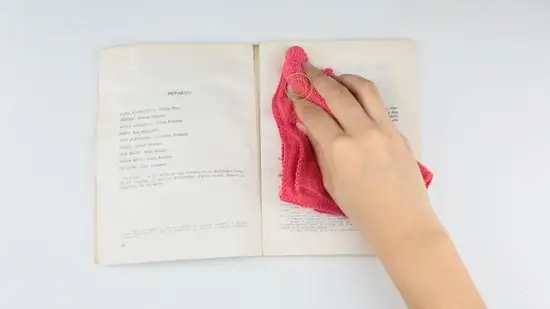
Step 1. Drain the remaining water from the book
The method of drying books with a hairdryer is perfect for damp books, but it can also be applied to wet books. However, before using a hairdryer, you must drain the excess water. Residual water can damage the binding and cause mildew or discoloration of the paper.
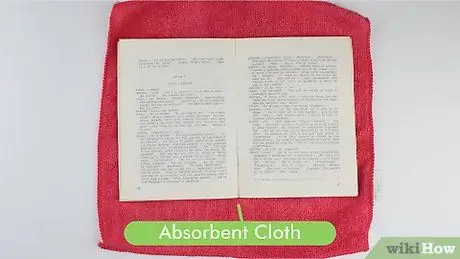
Step 2. Lay the book face up on a paper/absorbent cloth
This allows the book to remain in a stable position while you dry each page of the book. Hold the hairdryer with one hand, while the other hand holds the spine of the book.
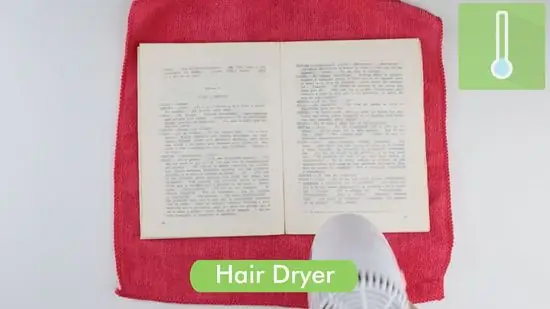
Step 3. Position the hair dryer at a distance of 15-20 cm from the book
Just as you are drying your hair, hold the dryer about 15-20 cm from the book so you don't damage the paper. You can use the cold or hot setting, then run the dryer over the pages until they are no longer wet or just slightly damp to the touch.
Be careful when using the heat setting because air that is too hot can damage the paper or even scorch it. When drying the pages of a book, touch the paper occasionally to make sure it doesn't get too hot. If the paper gets too hot, move on to the next page. You can continue the drying process once the paper has cooled
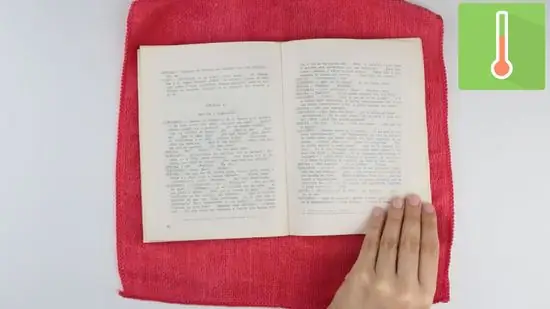
Step 4. Dry multiple pages at once
Divide the page into sections, starting with the bound section, and working your way down to the edge of the page. You can dry several pages at a time and move on to the next section once the paper is considered dry.
- Do not dry the page in a left and right motion, as there is a chance that you may skip a few spots and risk making the paper brittle or wavy.
- Drying books quickly can have a negative impact on paper. Book pages can be wrinkled or stretched. This may be the fastest method, but it also has the potential to damage the paper.
Tips
- If you borrowed the wet book from the library or a friend, contact the owner of the book as soon as possible to find out what to do in this situation. In some cases, they have specific procedures for dealing with problems like this, including dealing with the damage itself.
- If the book is just slightly damp, you may not need to follow the steps listed above. Instead, you can spread the cover between two tables, books, or other surfaces and let the pages hang freely for a few hours.
Warning
- While the above methods can help remove water from the pages of a book, don't expect it to make the book look like new.
- Do not dry books in the microwave as this can burn the paper, and damage the glue and binding.
- Any drying method can cause the paper to turn yellow, wrinkle, or change color.
- If a book falls into the gutter, it's best to throw it away. Books that fall into such a dirty place are not recommended to be recovered.






